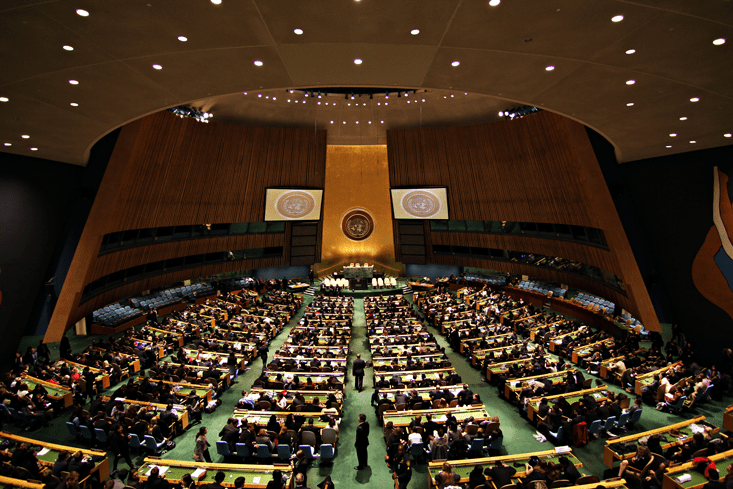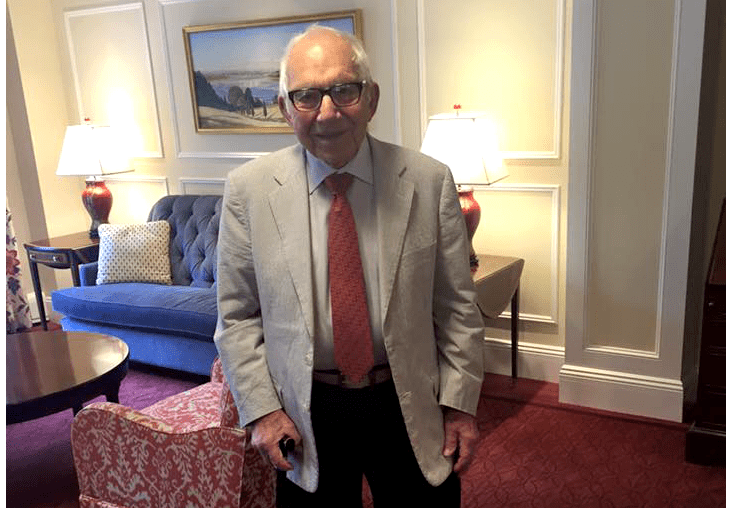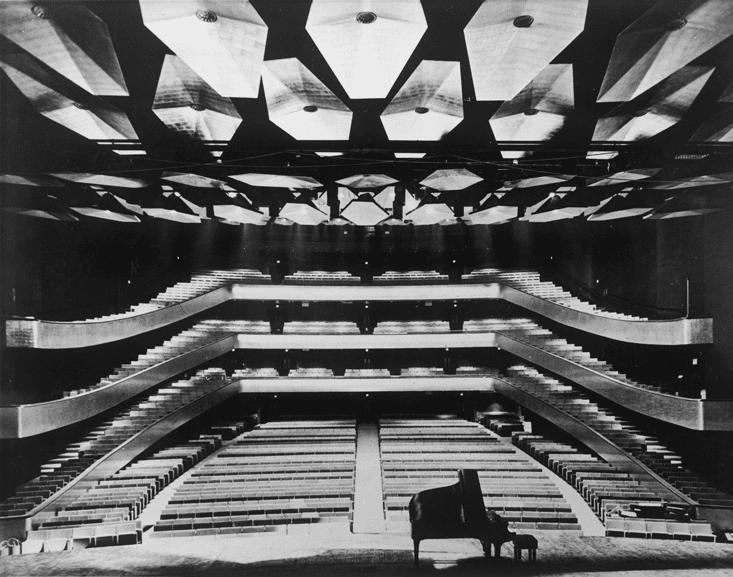The most celebrated and maligned living acoustician, Leo Leroy Beranek, now 101 years old, has had a storied career. As director of Harvard’s Electro-Acoustic Laboratory, he perfected the Hush-A-Phone, a telephone accessory that triggered a cascade of regulatory lawsuits from the 1950s to the 1980s. He created the world’s largest muffler to quiet jet engines. His company, BBN, developed ARPANET, the forerunner to the Internet and email. He designed the acoustics for the United Nations Assembly Hall in New York City.
He also has the dubious distinction of having shaped the interiors for the 1962 opening of Philharmonic Hall, the auditorium at Lincoln Center now called David Geffen Hall, which has gone done in acoustics history as a debacle—a much misunderstood one.
When the New York Philharmonic’s lease ran up at Carnegie Hall, the plan emerged to move the Philharmonic to Lincoln Center. After a months-long survey of the best concert halls in Europe that included meetings with the world’s top conductors and music critics, Beranek finished his recommendations for architect Max Abramovitz’s design (the final rendering of which ran as part of a front page feature for The New York Times in 1959).

But the Lincoln Center building committee criticized the original plans for Philharmonic Hall for not including enough seats. Though architect Abramovitz designed a hall with 2,400, the cap Beranek recommended to maintain sound quality, the cries of elitism led him to cram in 2,646 seats, closer to Carnegie’s 2,746.
To fit the extra seats without redesigning the whole hall, Abramovitz decided to bow the side walls without making Beranek privy to his change. Abramovitz then diverged from Beranek’s plan to have acoustical panels extend over the stage and just the first few rows of the audience. Instead, he had the panels extend over the entire seating area and had them welded together in a way that prevented an easy adjustment.
Beranek had also recommended the addition of surface irregularities to the side walls and ceilings—with niches and statues he found essential at the world’s best acoustically-appointed concert halls. But the budget-conscious building committee rejected that plan. “OK, you’re through,” he remembers being told. “We’re hiring an interior decorator.”
“It was do it their way, or die,” Dr. Beranek said. “What I should have done was quit. If I’d have resigned, that would have been my best answer. I wouldn’t have gotten blackened so.” But he was also consulting for the acoustics at Lincoln Center’s Metropolitan Opera House, and quitting one job meant losing the other.
After opening night, it was determined that the hall suffered from a weakness in the bass. Though Beranek aimed to propose adjustments to the contours of the hall, William Schuman, then president of Lincoln Center, sidelined him from the project as other acousticians were brought in to evaluate and improve the hall. The Times’ Harold Schonberg reported that a member of the committee of alternates saw the committee as coming “to save the acoustics profession.”
Beranek may find redemption for the long-ago fracas by putting his stamp on the venue’s $500 million renovation, scheduled to start in 2019. That’s because Paul Scarbrough at Akustiks, the Norwalk, Connecticut based firm doing the acoustics for the performance hall’s design from Heatherwick Studio and Diamond Schmitt Architects, contacted Beranek and plans to consult with him this summer at his upscale retirement home, Fox Hill Village in Westwood, Massachusetts. As for the story of Philharmonic Hall? “Well, it’s a long time ago,” Beranek said. “And I decided from the beginning not to let it bother me—just say, ‘It’s there. I can’t change it.’ ”
Beranek is still at work, even if he needs the help of his $4,000 a piece Phonak hearing aids; he published his latest paper this spring in the Journal of the Acoustical Society of America. Over a meal of arugula and kale salad, a chicken breast, a half order of beans, a half order of root vegetables, and raspberry ice cream, Beranek talked Nautilus through his undulating career in acoustics.

The National Defense Research Committee enlisted you to quiet airplanes and bombers during World War II. How did you land upon using fiberglass?
Well, it started off as the NDRC and then they changed it to ORDC. But the first request under NDRC was to develop a better material. There were two things. You wanted to get as much absorption as you could out of any given amount of material. But it had to be lightweight. You’re going in airplanes! So I then got to studying the question. As you make fiberglass smaller and smaller, the surface area [becomes] greater per square inch you might say, and the weight goes down faster than the area does. So you get a very light material with a heavy absorption because you’ve got a lot of surface area if you make it very small and put lots of fibers in. So I went to the Owens Corning fiberglass people and said, “Why don’t you try to make a material for me to test which has very small fibers in it?” And they said they’d never done that before. And they came back to me within three months, believe it or not, and they said, “We’ve got a little box of this material we’ve made. It cost us an enormous amount to make it, but tell us if it does what you want.” And it did. And then they geared up the company to make that in bulk. And that became the standard material for aircraft. Small fibers and light weight.
You pioneered some of the acoustics of airplane communications during WWII. Can you describe that process?
One of the first things we did was to test whether people’s hearing changed as you went up because we were dealing with unpressurized airplanes, remember. As you went up the pressure went down drastically, particularly at 30,000 feet. And now, does your hearing go bad? How much does your voice change? So we made tests at the Harvard Public School of Health, where they had a chamber where we could pump it down, and it was big enough to put people in, and we could then check their hearing as the pressure went down, and check the strength of their voice. Of course they had to have masks to get oxygen, but they could take them off and talk for a bit, you see? And we could see what the voice did. And the voice got weaker but the hearing did not change. So that’s the first important thing to know, is that the headsets that you used at lower levels can be used at higher levels, and they don’t change with altitude, because your hearing doesn’t change. So we got new headphones very quickly and [those for] all the armed services were not ones that changed with altitude. And the microphones—we experimented with those also and improved them. The microphones are inside the oxygen masks. And so our big contribution, early in the war, was improving the earphones and improving the microphones. And then the amplifiers—because the voice gets weaker—we put in an amplification that changed with air pressure. It moved the amplification up, so we could keep the level more constant.
Your anechoic chamber was important for both the war effort and for John Cage. How did that happen?
We built the chamber for a particular purpose: Have you heard of the ghost army? Well, the United States military wanted to fool the Germans. So they’re on the two sides of the [English] Channel, as you know. They wanted to make the Germans feel the invasion was coming north. So they set up a synthetic army over there, and they had tanks made of rubber. But the tanks would move around. If they wanted to move around, they had to sound like tanks moving around. Because you could even get the sound across the Channel. So we put these big loudspeakers there to do it. But these big loudspeakers had to be tested. And they were so loud, where were you going to test them? So we built the anechoic chamber to test these loudspeakers. And then we used it afterward to make acoustic tests of different kinds. I did the invention at Harvard. And I left Harvard and went to MIT, and then one day I got a telephone call that said, “There’s a guy named Cage, who’s a composer, wants to go in that chamber.” Well I said, “I’m no longer at Harvard, you’ll have to go to Professor [Frederick V.] Hunt.” So somebody called Professor Hunt, and Cage went into the chamber with Hunt.
You hit a snag when designing the acoustics for the United Nations Assembly Hall in New York. What was it?
Well the U.N. was interesting. In the first place, you must remember, we [BBN] were the only acoustical company practically in the United States. So they didn’t really have any other place to go [laughs] unless they wanted to take a beginner.
So I went to the loudspeaker company I chose and I said, “Tell me something.” And the chief engineer says, “Come with me, I’ve got a demonstration to make.” He said, “If you take our microphones, which have a flat frequency response over a wide range, and you take these new loudspeakers we got, which also radiate fairly uniformly … If I get the phase right, with the microphone in front of the loudspeaker it won’t ring.” And I said, “Well that’s hard to believe!” And he said, “Well let me demonstrate.” So by having a sort of constant level and holding the phase constant, and the loudspeaker being the same way, you could cover the speech range [of frequencies], let’s say from about 250 Hz up to about 3,000, without ringing. You could have the microphone in front of the loudspeakers.
Then that’s what I then went back with and I told Harrison, “Well, we’ll make a trial. We’ll put it in the back wall—the loudspeakers—but you’ve gotta pick these loudspeakers, nobody else’s, and the microphones going on the podium are going to be those microphones and nobody else’s,” and he agreed to that. And now came a big argument. They had a head man from Sweden, I think, who was in charge of telecommunications at the U.N., and he resigned. He says, “I’m not gonna be here when you have that mistake. That place is going to re-feedback and sing so bad, and these guys don’t know what they’re talking about!” And so he quit and went back to Sweden because of my design! Well, we also put sound-absorbing material around the loudspeakers so there was no resonance around them, and then came the test, and by God it worked! [Laughs.] And I think they’re using the same thing today!

What was the Hush-A-Phone fight about?
[Hush-A-Phone President H.C.] Tuttle came to me and asked me to develop a new attachment whose sole purpose was to give you some privacy to talk [cups mouth]. They said this is useful maybe in doctors’ offices and lawyers’ offices, stockbrokers’ offices for communication where you didn’t want people to hear. I developed this attachment so it really preserved the voice quality pretty well—you could really put it on and still understand the voice about the same. And that’s all it was. Just this attachment.
The Hush-A-Phone Company sold these but then the Bell Telephone people came around and said, “You can’t put that on your phone. You can’t attach this thing, because we have a code that’s by Federal Communications Code, that no-one can make a foreign attachment to the telephone system. So we take this off and if you persist in using it, we’re going to cut off your telephone service.” That’s what the telephone company told the people that bought this.
So Mr. Tuttle, who ran the Hush-A-Phone Company, said, “Well, let’s take this before the FCC and argue that it doesn’t make sense to restrict people from using our Hush-A-Phone.” The FCC took very serious consideration on this, and they had a hearing and three judges and we presented our case and Bell presented their case. They said, “Anytime you attach anything you make it sound worse—it’s a degradation of the telephone system.” And we tried to show that it didn’t degrade the system appreciably [laughs]. The FCC ruled with the telephone company and said, “You can’t put it on.” So we took it to the United States Court of Appeals. [They] looked the evidence over and they said—there was one fellow there who asked a question: “Is this any different from putting your hand around the telephone?” And the guy answered and said, “No, it’s the same kind of thing. You can do it with your hand but it’s not comfortable.” So the court of appeals said, “Well if this thing is no different from your hands you can’t restrict it because you can’t restrict people [from] using their hands. So you can use
Your acoustics work in Japan was heralded as a major comeback for your music-oriented design. Why was it so successful?
You’re working with an architect, and in this case the architect [Tahahiko Yanagisawa] wanted to do everything he could with good acoustics but he still wanted his design, so we had to work with him carefully. Now the [Tokyo Opera City] Opera House—he did not want to go to the old circular opera house. But he wanted to have a sound that was uniform through the hall and also that the singers on stage could move around and their voice wouldn’t go up and down. So in the case of the Opera House, we developed a sort of horn idea, and it’s built into the side walls and into the canopy. It’s sort of a horn thing that distributes the sound quite uniformly over the hall. It’s the best I’ve ever done. And in testing we had singers walk around the stage and keep singing while they were walking. And the sound did not change in amplitude [while listening] in the audience.
Even noted acousticians don’t get preferential treatment. Can you describe the kerfuffle that happened at La Scala opera house in Milan in 1960?
Well, it was the gala night and I did have a dark suit and a white shirt and a black bowtie, which was not actually a tuxedo but I thought it would get by, but that wasn’t what stopped me. It was wintertime, and I had a wool scarf. And they stopped me and said, “You can’t go in.” “Why?” “Well, you’re not dressed properly for a gala!” In a gala you don’t come with a wool scarf; you have a white silk one. So my wife was dressed properly, and they let her go in, and they put me up in heaven. But heaven was good. I sat next to the architect.
What is most important to ensuring pleasant sound quality, both in terms of orchestral music and in general?
Well you know, you want some early lateral reflections. That seems to be a very important part of our understanding.
What is the most beautiful sound, and what is the sound that most annoys you?
I don’t know if I can answer that. Noise is annoying, so noise is a sound you don’t like. And particularly where it occurs when you want to not have noise. Maybe a little noise when you’re sleeping is a good idea. But when you’re talking with people, you don’t want too much noise around you. And you don’t want noise with your music. So you want a certain type of quiet. And I think natural sound, coming from a real performing group, whether it’s opera or a concert, is much better than hearing it through loudspeakers. So that’s the other side. You know, Bose is famous for having loudspeakers. But my wife had a chance to talk with [Amar] Bose a lot, and she finally said to Bose, “What do you think about the difference hearing music in Boston Symphony Hall and hearing music over your loudspeakers?” “Well,” he says, “If I tell you the truth, the difference is like canned soup.” You get it? Canned soup compared to real soup! [Laughs.]
Ross Kenneth Urken is a writer living in Manhattan. Read more of his work here.



